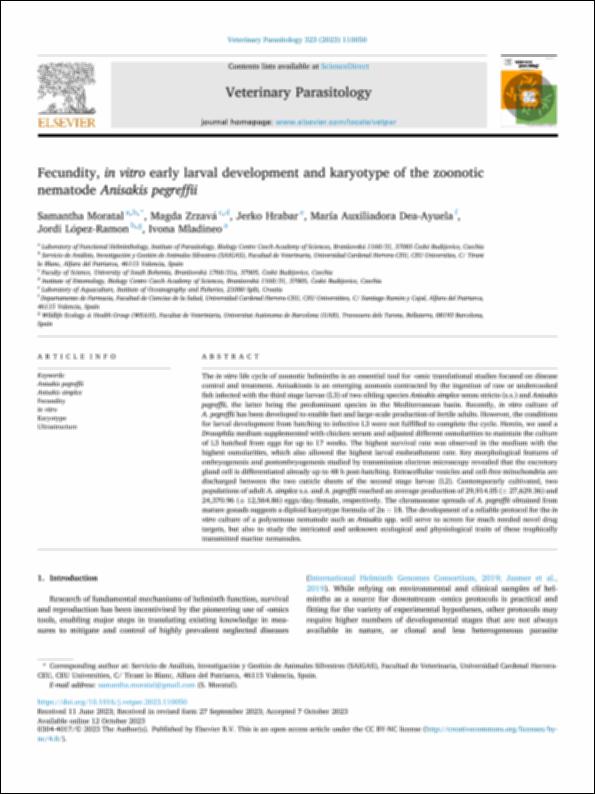Please use this identifier to cite or link to this item:
http://hdl.handle.net/10637/14922Fecundity, in vitro early larval development and karyotype of the zoonotic nematode "Anisakis pegreffii"
| Title: | Fecundity, in vitro early larval development and karyotype of the zoonotic nematode "Anisakis pegreffii" |
| Authors : | Moratal, Samantha Zrzavá, Magda Hrabar, Jerko Dea Ayuela, María Auxiliadora López Ramon, Jordi Mladineo, Ivona |
| Keywords: | Pez marino; Marine fish; Parasitología; Parasitology; Enfermedad transmisible; Infectious diseases; Enfermedad animal; Animal diseases |
| Publisher: | Elsevier |
| Citation: | Moratal, S., Zrzavá, M., Hrabar, J., Dea-Ayuela, M.A., López-Ramon, J. & Mladineo, I. (2023). Fecundity, in vitro early larval development and karyotype of the zoonotic nematode "Anisakis pegreffii". Veterinary Parasitology, vol. 323 (nov.), art. 110050. DOI: https://doi.org/10.1016/j.vetpar.2023.110050 |
| Abstract: | The in vitro life cycle of zoonotic helminths is an essential tool for -omic translational studies focused on disease control and treatment. Anisakiosis is an emerging zoonosis contracted by the ingestion of raw or undercooked fish infected with the third stage larvae (L3) of two sibling species Anisakis simplex sensu stricto (s.s.) and Anisakis pegreffii, the latter being the predominant species in the Mediterranean basin. Recently, in vitro culture of A. pegreffii has been developed to enable fast and large-scale production of fertile adults. However, the conditions for larval development from hatching to infective L3 were not fulfilled to complete the cycle. Herein, we used a Drosophila medium supplemented with chicken serum and adjusted different osmolarities to maintain the culture of L3 hatched from eggs for up to 17 weeks. The highest survival rate was observed in the medium with the highest osmolarities, which also allowed the highest larval exsheathment rate. Key morphological features of embryogenesis and postembryogenesis studied by transmission electron microscopy revealed that the excretory gland cell is differentiated already up to 48 h post-hatching. Extracellular vesicles and cell-free mitochondria are discharged between the two cuticle sheets of the second stage larvae (L2). Contemporarly cultivated, two populations of adult A. simplex s.s. and A. pegreffii reached an average production of 29,914.05 (± 27,629.36) and 24,370.96 (± 12,564.86) eggs/day/female, respectively. The chromosome spreads of A. pegreffii obtained from mature gonads suggests a diploid karyotype formula of 2n = 18. The development of a reliable protocol for the in vitro culture of a polyxenous nematode such as Anisakis spp. will serve to screen for much needed novel drug targets, but also to study the intricated and unknown ecological and physiological traits of these trophically transmitted marine nematodes. |
| URI: | http://hdl.handle.net/10637/14922 |
| Rights : | Open Access http://creativecommons.org/licenses/by-nc/4.0/deed.es |
| ISSN: | 0304-4017 |
| Supported by: | Acuerdo Transformativo – 2023 |
| Issue Date: | 12-Nov-2023 |
| Center : | Universidad Cardenal Herrera-CEU |
| Appears in Collections: | Dpto. Producción y Sanidad Animal, Salud Pública Veterinaria y Ciencia y Tecnología de los Alimentos |
Items in DSpace are protected by copyright, with all rights reserved, unless otherwise indicated.


